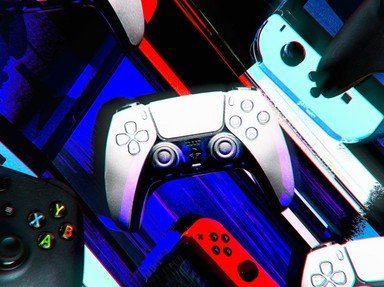Quiz Answer Key and Fun Facts
1. #50 - "Brain Age 2: More Training in Minutes a Day" (DS)
What is NOT one of the extra activities on the game?
2. #49 - "Bust a Groove" (PS1)
What is the full name of the character who has a stage that plays the song that the game is named after?
3. #48 - "Pokemon Trading Card Game" (GBC)
Besides the promo cards, the cards in this game went up to what series in the cards (examples: Base Set, EX Deoxys etc.)?
4. #47 - "Donkey Konga" (GCN)
"Donkey Konga" had a music theme from each of the following video games except for what?
5. #46 - "Mario Golf: Toadstool Tour" (GCN)
In which course did obstacles, normally not found on a golf course, start appearing?
6. #45 - "Rayman: Raving Rabbids" (Wii)
In the video "Very Useful Scientific Facts for Rabbids #3" what does the Rabbid pull out from behind his back?
7. #44 - "Wii Sports" (Wii)
Which sport is the only one to use the Wiimote along with the Nunchuk?
8. #43 - "Pokemon Snap" (N64)
Not counting Pokemon symbols or Pokemon that only have one evolution stage, how many Pokemon appeared as the only one in their evolution process?
(Note: Do not count evolutions after the Kanto region such as Smoochum or Scizor.)
9. #42 - "Harvest Moon: Magical Melody" (GCN)
What is Ann's birthday?
10. #41 - "Mario Kart 64" (N64)
Is it possible to finish Wario Stadium in under 30 seconds?
11. #40 - "Teenage Mutant Ninja Turtles IV: Turtles in Time" (SNES)
What is the time setting for "The Final Shell Shock"?
12. #39 - "Extreme G" (N64)
What was the name of the hidden rider you got after beating the last cup on the easiest level?
13. #38 - "WarioWare: Smooth Moves" (Wii)
In the video game store, what position do you use to guide Link on to a large tree stump?
14. #37 - "Mario Party 8" (Wii)
How is the Lucky Space different on the board Bowser's Twisted Orbit?
15. #36 - "New Super Mario Bros." (DS)
What item would you need to access Worlds 4 and 7?
16. #35 - "Tetris DS"
Even though the Marathon mode is mainly centered around Mario, you will eventually get to a Zelda mode if you reach a high enough level.
17. #34 - "Yoshi's Island DS"
Which one of the following babies can Yoshi not carry?
18. #33 -"The Legend of Zelda: Four Swords Adventures" (GCN)
Vaati is the main boss in this game.
19. #32 - "Mario & Luigi: Partners in Time" (DS)
Fawful, the lackey for Cackletta in "Mario and Luigi: Superstar Saga", appears where?
20. #31 - "MegaMan X" (SNES)
Throughout the game, certain effects will happen to certain stages if you beat a certain boss before taking on another bosses stage. How many stages will be affected by these changes?
21. #30 - "MegaMan X4" (PS1)
If you want to get all four upgrades in the game, playing as X, which weapon do you not need?
22. #29 - "Donkey Kong Country 2: Diddy's Kong Quest" (SNES)
In which section of "Animal Antics" is the sole bonus barrel?
23. #28 - "Star Fox Assault" (GCN)
Every character from the original Star Wolf team appears in this game.
(Hint: There were four characters in the original Star Wolf team.)
24. #27 - "Metroid: Zero Mission" (GBA)
"Metroid: Zero Mission" was based off which game of the "Metroid" series?
25. #26 - "Rayman Raving Rabbids 2" (Wii)
Which one of the following games does not require you to shake the Wiimote in an upright position?
Source: Author
SandK
This quiz was reviewed by FunTrivia editor
kyleisalive before going online.
Any errors found in FunTrivia content are routinely corrected through our feedback system.

